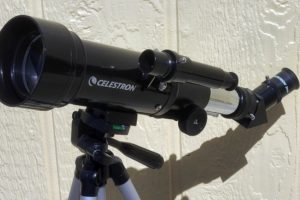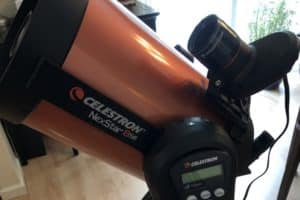Teaching astronomy to children feeds their natural curiosity and creativity. It can make them better thinkers and explorers, and help them develop a lifelong passion for the stars. Parents and educators can make astronomy lessons for kids as young as pre-K and scale the volume and complexity of content to fit the educational needs of any specific age group. With this guide, we aim to give some inspiration and practical tips that may help spark the interest of your child in astronomy.
See also:
This free booklet is available in 2 formats (both are available on the page you’re already on). First, as an interactive flip-booklet (immediately below, click to view full-screen). Second, if you would rather read a “plain text” version, keep scrolling below the interactive flip-booklet… the rest of this page is for you!
Click Here to Download or Share
Astronomy for Kids: Teaching the Science of Space to Young Stargazers (With Pro Tips and Activity Ideas)
The Journey Begins
Every child has sat under a moonless night sky, gazing up at the stars and wondering what’s out there. Space-oriented sci-fi favorites, from Lost in Space to Star Wars and Star Trek, have tapped into the vast mysteries of the universe to entertain us for generations. The infinite possibilities spark our imaginations and leave us in humble wonder.
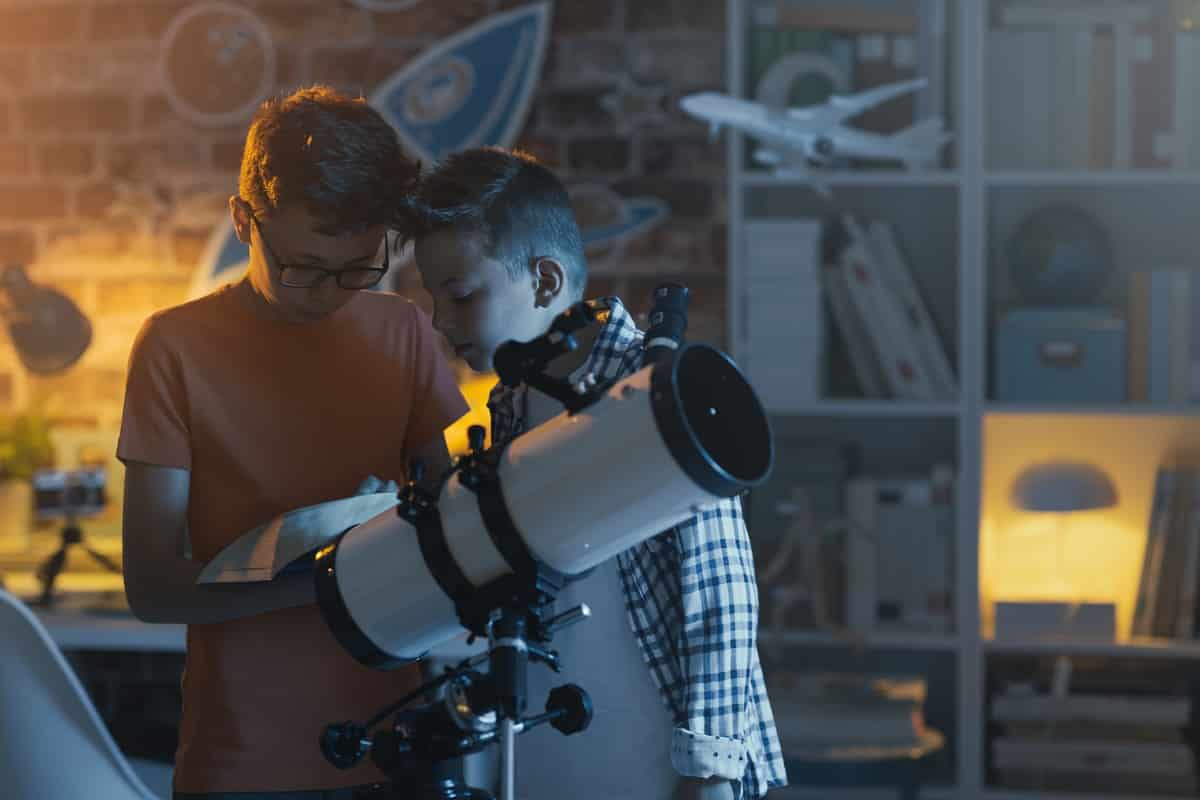
Image Credit: Licensed from iStock / demaerre
What is Astronomy?
The word astronomy comes from the original Greek and means “the science that studies the laws of the stars.” It’s hard to imagine a more literal or more appropriate meaning, as astronomy not only involves the study of the stars, but also the laws that govern their very existence.
For example, although we understand the lives of stars fairly well, it’s not 100% certain as to how planets form, or even how many planets may be in the galaxy. Current thinking is that there could be as many as 100 billion planets in our Milky Way galaxy alone, but only 300 million of them could have just the right conditions to support life. Scientists have validated 4,569 planets as orbiting distant stars, and these estimates change regularly. In November 2021, scientists announced the application of ExoMiner machine learning to Kepler telescope data to identify another 301 planets!
Those numbers will change as our understanding of the universe changes. A lot of astronomy, like all sciences, is theoretical, but we know some things for sure. For example:
- The planet Neptune has the fastest winds in the solar system. It has high altitude winds that can reach 1,100 mph, or about 1.5x the speed of sound! We know this because the Voyager 2 space probe passed the planet in 1989 and measured the wind speeds there.
- The Earth is tiny! The mass of Jupiter is over 300x bigger than Earth, and you could fit over 1,000,000 Earths inside the Sun!
- The largest planet in our solar system, Jupiter (yes, the one 300x bigger than Earth), spins faster on its axis than any other planet. In fact, it only takes 10 hours for the massive planet to complete one rotation, i.e., one Jupiter day!
Astronomy, then, is more than just the study of the stars we can see in our night sky. It can also be the study of everything that lies beyond the Earth, including the celestial bodies of the solar system and the universe as a whole. Whether they be nebulae, star clusters, galaxies or the entire universe itself, if it exists beyond our atmosphere, it exists within the purview of astronomy!

Image Credit: NASA
Isn’t Astronomy Too Difficult for Kids?
No! Parents and educators can effectively teach astronomy to kids and students of all grade-levels with an age-appropriate curriculum.
We want to inspire our children and students, to teach them to develop solutions for the problems they find, and to train them to ask questions and find answers. This will lay the foundation for deeper and more technical knowledge at a more advanced age.
Studying astronomy doesn’t have to mean using complex mathematical formulae or understanding advanced physics, but it can incorporate real science at a deep enough, age-appropriate level.
Astronomy, as a science, offers a fantastically broad range of facets and areas of study. Physics, chemistry, math, cartography, reading/writing, visual & spatial arts… all areas that invite innovation and discovery… it’s all there.
As a quick overview, here are some topics you can introduce at various education stages:
- Pre-K: The basics, such as the planets of the solar system. Which is largest? The nearest/furthest from the Sun? Which planets can you see with just your eyes in the night sky?
- K-2nd Grade: The differences between stars and planets, the Earth, the movement of the Sun across the sky (sunrise, sunset, east and west), orbits and what causes the seasons.
- 3rd-5th Grade: Each of the planets in greater detail, the phases of the Moon, the stars and constellations.
- Middle School: Astronomical history, the Sun and Moon, eclipses, asteroids, comets and meteors, galaxies, and the chemistry and life spans of the stars.
- High School and Beyond: The structure and origins of the universe, celestial coordinates, orbital laws and the different types of telescopes.
Astronomy can be as simple or complex as you make it, and with a powerful imagination as infinite as the universe itself, you could explore the cosmos for a lifetime. By provoking this natural desire for discovery—utilizing well-rounded skills and their limitless, lifelong potential—astronomy offers a truly awesome adventure for kids of all ages.
Early Experiences Can Spark a Lifelong Passion
Neil de Grasse Tyson
Famed scientist Neil de Grasse Tyson strongly advocates teaching astronomy as early as possible. He certainly got hooked early. In his NBC Nightly News interview in 2017, Tyson recalls visiting the planetarium at age nine and knowing he wanted to become an astrophysicist by age 11.
Tyson also recalls a funny story about the first time he visited a planetarium. After going into the facility’s “star dome” (a big room that worked like a telescope, allowing the kids to see an unfiltered view of outer space), he thought they’d faked the whole thing. Growing up in Brooklyn, NY, Tyson was used to seeing a polluted sky with cloudier views and fewer stars. In his mind, such an abundance of celestial objects could never fill the skies – therefore, it had to be a hoax! Resolving that conflict was a key factor in starting his journey.

Image Credit: Wikipedia
Tyson cites this experience as a crucial turning point in his life. He was struck by wonder on his first trip to the planetarium and that he had to learn more about the universe. He has, of course, gone on to become one of the most prominent scientists in the field, and it’s all thanks to a trip to the planetarium as a 9-year old boy.
Ana Humphrey
Lesser known, but no less impressive, Ana Humphrey won the 2019 Regeneron Science Talent Search and is currently an astrophysics student at Harvard. Ana mentions in this wonderful interview that her love for science started at age 10, when she became aware of the environmental issues and community impact of mountaintop coal mining. She also attended a number of science fairs and, after speaking to the winner of one such contest, was inspired in 6th grade to challenge herself through those same science fair projects.
Seeing others solve real world problems fed her passion for the environment, for asking hard questions and eventually for using mathematics, research and community efforts to solve related issues. She learned key lessons in her efforts, including:
- To identify issues in our community and create concrete action plans to address them;
- To not be afraid to ask questions, but also to not be afraid to find the answers; and
- That, while being smart is good, being kind and respectful to others is more important.
In high school, Ana achieved extreme success at multiple science fairs with projects related to the environment and astronomy. One project that used mathematical models to discover potential locations for exoplanets won her the top prize at the Regeneron Science Talent Search.
Two very different backgrounds, but both inspired by exposure to science and astronomy at a young age. Not everyone can be on the same level as Neil de Grasse Tyson and Ana Humphrey, but we hope the tips and projects in this leaflet help you to find inspiration and inspire others as well.
Choosing A Curriculum
Unfortunately, not all astronomy-related materials are created equal. Some materials retread common pitfalls that you can keep an eye out for. We’ve detailed some common issues that we’ve come across below.
Breadth vs. Depth
We commonly hear this question: Should children focus for a longer time on one specific area of study, or cover the basics across broader curriculum? The more general approach might seem to make sense, particularly when framed as aiding the child in “searching for one’s passion.” Exposing children to a wide variety of topics, and allowing them to gravitate towards the ones that spark their interest, seems like a wise course of action – or so the thinking goes.
However, a groundbreaking study published by researchers at the University of Virginia showed that young people learn better when they’re taught a subject in depth, rather than being exposed to a range of subjects all at once. Not only did students exposed to the same subject for a longer period of time better retain the information, but they also went on to perform significantly better at the university level, even after controlling for external variables.
One explanation for this might be that kids learn best when they’re passionate. When they get excited about the material and experience a burning curiosity to learn the answers, they can learn and retain information much better. Passion takes time to develop. Most kids aren’t taught about the cycles of a star and immediately fall head over heels in love with astronomy. Instead, they need time for the concepts of astronomy to sink in and for a passion to take root.
Another reason may be that too much information can overwhelm and lead to poor levels of retention. Kids trying to learn about too many diverse concepts in too short of a time leads to uninspired students more focused on memorizing facts than developing genuine interests.
Teachers and parents may therefore want to consider:
- teaching astronomy on its own as a focused program;
- giving kids weeks or even months to explore wherever their curious minds take them; and
- finding materials that provide more depth.
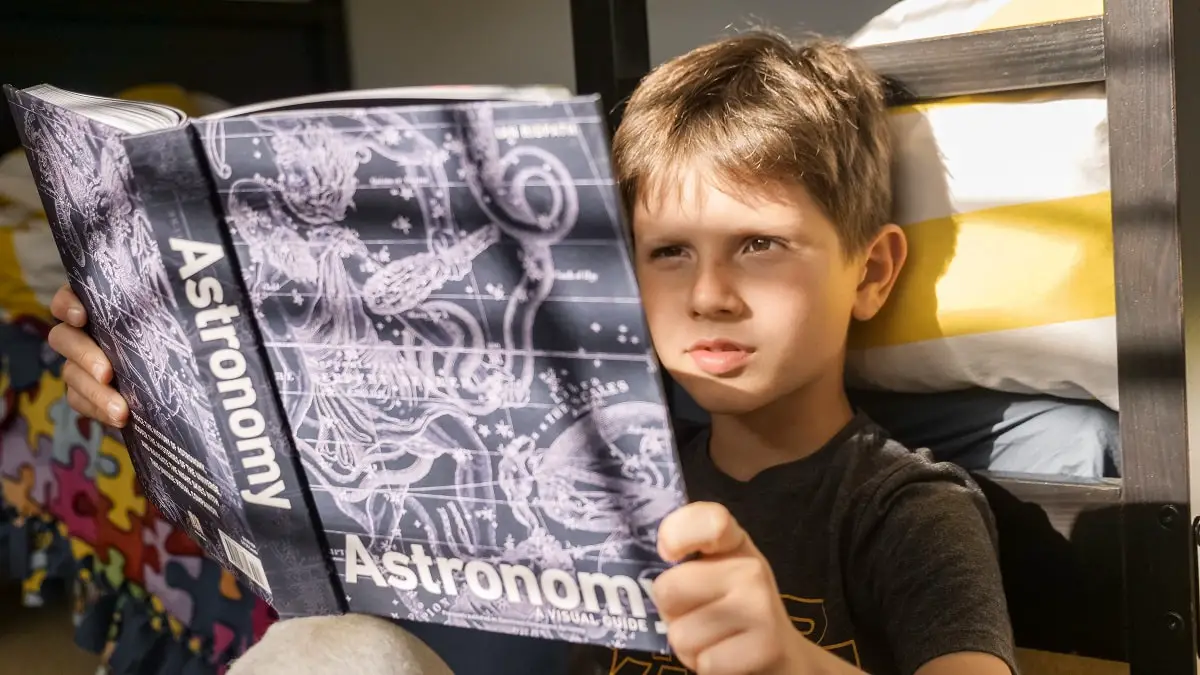
Image Credit: pexels.com / Kindel Media
Crafts and History, vs. Science
When choosing the best materials for teaching astronomy to your kids, another pitfall to keep in mind is whether the materials truly focus on the science or whether they are really more arts & crafts or history focused.
For example, solar system models can certainly get younger children interested in space and teach the names and order of the planets from the Sun. They are, of course, also extremely rudimentary models, woefully inaccurate as to the scale of the planets relative to each other, the relative distances between the planets, and the general location of the planets in respect of each other. We view other projects, such as glitter-covered Styrofoam ball comets, as even less impactful, and really more like fun arts and crafts than science.
NASA has a simple video (see below) demonstrating the challenges presented by solar system models:
Similarly, many astronomy-focused books and materials for kids actually spend much more time on the history than the science. These books might describe important people and their discoveries, but do not get into any of the demonstrative lessons, principles, experiments and processes that young people need to truly grasp the science behind it all.
This doesn’t necessarily mean the materials have no value; they may help to show how an astronomer identified a problem or had a question, and then went about solving it – the type of thing kids may find inspirational. However, you may want to ask yourself if you’re teaching science or simply the memorization of historical / narrative details.
Time-Specific vs. Generally Applicable Materials
A quick note on time-specific versus generally-applicable materials. When purchasing materials for kids related to astronomy, keep in mind that the sky changes throughout the night / year and differs over various parts of the earth.
As such, you’ll need to be careful when purchasing static materials, i.e., ones that purport to show you celestial objects without accounting for your latitude, time of year, etc. You may therefore find a sky-gazer’s almanac or a smartphone app more useful than a static map of the entire night sky or an image from a book.
Age Appropriateness
Parents and educators should also consider whether the material is too simple or advanced for their child / student. For kids aged five and younger, education should often focus on more general exposure and fun. Children can be shown astronomy through videos and pictures, learn vocabulary (very basic astronomical terminology, like the names of the planets, and terms such as stars, galaxies, and black holes) and play games with the subject matter.
As students transition into elementary school, understanding should be expanded. Children can begin to understand what makes up a star, what are the cycles of a star, and how stars come to exist. They can also begin to appreciate how concepts relate and fit into a large cosmic framework. Learning should be driven by questions, and the learning environment should become a forum for understanding questions that they’re actually curious about.
In middle school and high school, kids can grasp the more complex aspects of astronomy. The “why” becomes very important in what’s being taught, and the kids need to understand both the practical applications of the subject as well as their role in solving the problems and questions that they encounter. Project-based, self-directed learning and experimentation can really take off at this age, and the kids should be allowed to take responsibility not only for asking questions but in finding the answers to them.
Sample Curriculum Materials
Some curriculum material options that we found useful and/or referred to in preparing this leaflet include the following:
- NASA’s Universe of Learning, an integrated astrophysics STEM learning and literacy program: https://www.universe-of-learning.org/
- Sky Lights, blog covering astronomy, meteorology, climatology, chemistry, physics, optics, earth & space science, and others, that aims to help students and homeschoolers: https://sky-lights.org/
- Sky & Telescope’s Homeschool Astronomy Resources for K-12 Students: https://skyandtelescope.org/homeschool-resources/
- Starry Night Education: research proven software solutions for grades 9-12 astronomy education: https://www.starrynighteducation.com/products-astronomy-education-high-school.html
- Home School Mom’s list of astronomy related resources: https://www.thehomeschoolmom.com/homeschool-lesson-plans/astronomy/
- Forest Trail Academy’s online high school astronomy class: https://www.foresttrailacademy.com/astronomy-course-curriculum.html
- Rainbow Resource Center’s middle school astronomy teaching materials: https://www.rainbowresource.com/category/10577/Middle-School-Astronomy.html
- Education.com’s solar system lesson plan for young kids: https://www.education.com/lesson-plans/second-grade/earth-science/
How to Get Kids Into Astronomy and Under the Stars
While it’s important to learn and understand the fundamentals of astronomy, nothing beats going outside on a clear night and looking up at the Moon, planets and stars. That said, it can be difficult to know where to begin. We’ve compiled a few ideas on how to get started:
- Learn to identify the phases of the Moon. (See below for a fun activity to demonstrate the phases of the Moon and why the same side always faces toward us.) Watch the Moon change phase and track its movement across the sky. Trying to guess where the Moon will be the following night, and which phase the Moon will be in one-, two- or three-weeks’ time, can provide a fun way to explore these concepts.
- Learn to identify the planets and track their movements. Each planet has a different color and brightness – which shines brightest? Are there any that appear to be getting brighter or fainter? Keep an eye on the planets and their positions in relation to nearby bright stars. Which planets move the quickest? Which are slowest? If a planet approaches a bright star, how long do you think it will be before it appears next to the star?
- Understand why and how the view of the night sky changes during the course of the night and through the changing seasons. Go outside at about an hour after sunset and note where the brightest stars and planets are in the sky. Which ones are setting in the west? Which stars are rising in the east or appear to be overhead? Then return a few hours later (if the children have yet to go to bed) and see how the view has changed. Which stars have set? Which stars now appear overhead? On a more long-term scale, come back a month later at the same time and compare the view again.
- Learn to identify the Big Dipper (from winter to summer) and Orion (from winter to early spring) and how to use them to find other stars and constellations. How do you find Polaris, the north pole star? Where is Sirius, the brightest star in the sky? How can you find the constellations Leo and Gemini?
- Learn to locate and identify various deep sky objects. Start with naked eye targets, such as the Pleiades and Hyades, the Andromeda Galaxy, the Beehive Cluster or Mizar & Alcor, and then move on to binocular objects, such as M41 or M35. How do the naked eye objects appear when observed through binoculars?
How to Make Astronomy Fun
Once an educator or parent has made the decision that they’re ready to teach astronomy to their children, what material should be taught? Which activities will the learners find most interesting?
Pro-Tip: To Start, Keep It Simple & Social
Initially, getting your bearings and teaching children about astronomy basics doesn’t need to be that challenging. The following tips can get you off on the right foot:
1. Learn the Basics
Getting a handle on the planets and constellations, your primary objects in the night sky, is easier than it sounds for all but the youngest among us. We’ve already mentioned solar system models as a way to help younger kids conceptualize the planets. Planetariums are great resources if you have one near you, but you can also easily find a number of other star maps and informative visuals online to help visualize the night sky, or download apps, such as Sky Safari (which allows you to find night sky objects by simply pointing your phone in their direction!).
For constellations in particular, we recommend the book:
Signposts to the Stars: An Absolute Beginners Guide to Learning the Night Sky and Exploring the Constellations, by Richard J. Bartlett
(Note: Richard is a regular contributor to TelescopeGuide.org and helped with writing/editing on this article.)
2. Join a Local Club or Society
For parents/kids and teachers/students who truly take an interest in astronomy, local clubs of other hobbyists offer a great chance to meet peers sharing the same passion. Seeing peers learn and challenge themselves can help students find inspiration and learn what it takes to develop into a more serious astronomer.
3. Get Out There & Stargaze!
Stargazing provides a great activity for families to enjoy together. Kids and parents together, outside, under a beautiful night sky allows the kids to take the more formal information they’re learning in class into more casual conversations with their parents and siblings. Actually stargazing, versus working through projects and books, helps cement the real-world applicability and sense of wonder that kids need to really become passionate about a subject.
Stargazing Tips
Our website, www.telescopeguide.org, has other resources to help you get started, but we’ve provided a few tips for stargazing beginners:
- When stargazing, avoid light “pollution.” By that, we mean light from cities / streetlights, a full moon, and other sources that cause starts and night sky objects to appear faint. You’ll want to go on a night, and at the time during that night, when the sky is as dark as possible and preferably get away from cities and towns. Or even better, you can visit a dark sky location for the best possible stargazing experience.
- You don’t need a lot of equipment to begin. Unlike other disciplines that require expensive equipment, amateurs and professionals alike can enjoy the heavens with nothing more than their eyes and a clear night sky. In fact, the best place to start might be without any equipment at all. Starting with your eyes, a map of the night sky and a journal of what you see provides a great way for beginners to form a general understanding of what they’re seeing. Identifying constellations and specific stars and planets creates the mental map that all young stargazers need.
- If you do want to amp up the experience with some binoculars or a telescope, beginners have a lot of great options. These days, you and your kid can take some pretty cool photos of the moon with a basic, low end telescope, your smart phone and an adapter. Seeing your first lunar snapshot or the Milky Way for the first time offers just the type of experience to spark lasting passion in kids.
There are plenty of great options for a first telescope for kids. Here’s an example of an inexpensive starter option – the Celestron FirstScope (our review here).
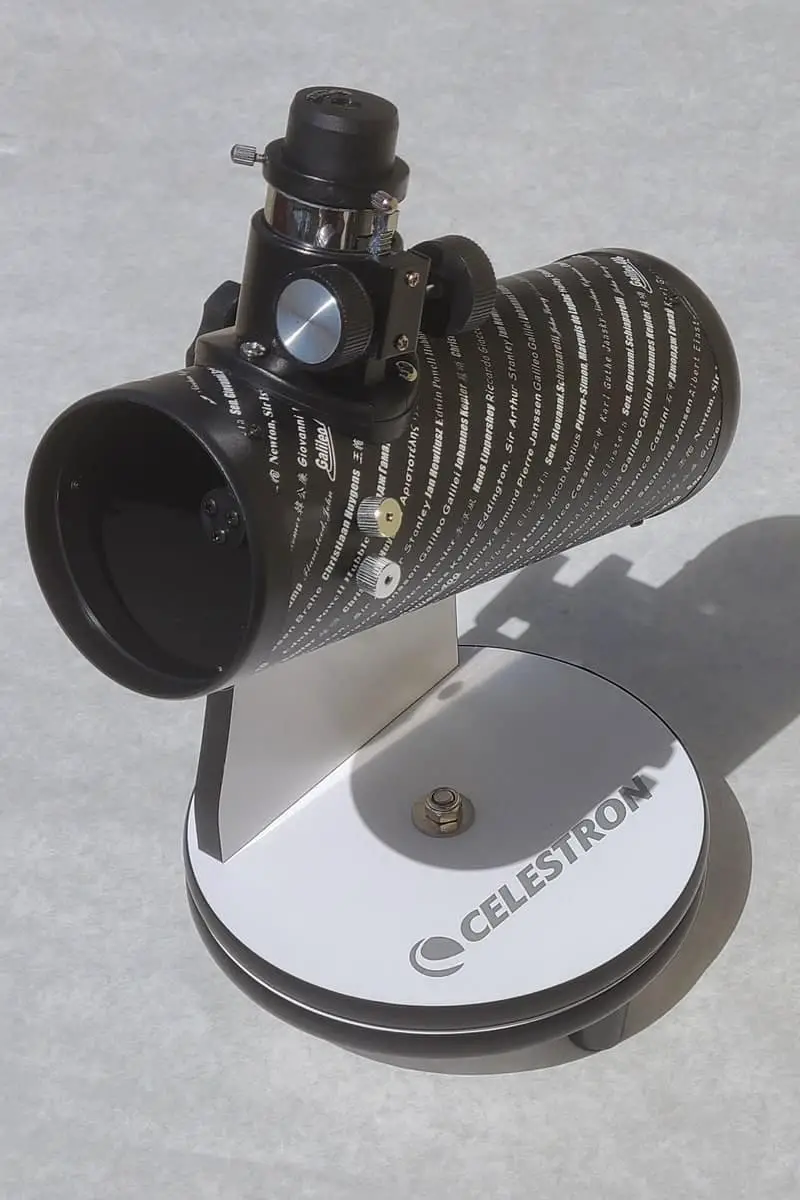
Image Credit: Richard Bartlett / TelescopeGuide.org
Astronomy-Related Activities for Kids
Experiments and projects can also help make learning astronomy fun for kids. We’ve set out some examples of astronomy activities for kids to consider below!
Moon Base Design Challenge
Surviving on the moon, another planet or even traveling through space presents many challenges, and scientists from around the world have studied these issues for generations.
For this exercise, students pretend they’re one of these scientists, in charge of establishing a moon, space or planetary base. They must design the base to meet basic needs – for example, how will you eat, breathe, generate electricity, exercise and live? What will the conditions on the surface be like? Gravity? Weather? What challenges will you face?
Designing a moon base (or a space or planetary version) offers a fun way to stimulate kids’ imaginations, teach them about interstellar objects, and have them research and design solutions for real challenges. It also pushes them to condense and articulate what they know about space and the necessities of life. Parents and educators can guide the scope of the project from simple scenarios for younger kids to more complex and detailed requirements for older ones.
Students love this project as it puts them in control. They’ll need to figure out what challenges could arise and think creatively to realize their solutions. It requires multi-level thinking and the application of facts they’ve learned beforehand about the moon, space or planet in question.
Kids can create the “moon base” from a cardboard box and simple household items. it’s important to have a design map with explanations of the model, and to have the children articulate their design and the challenges they faced. Here’s a real-life example:
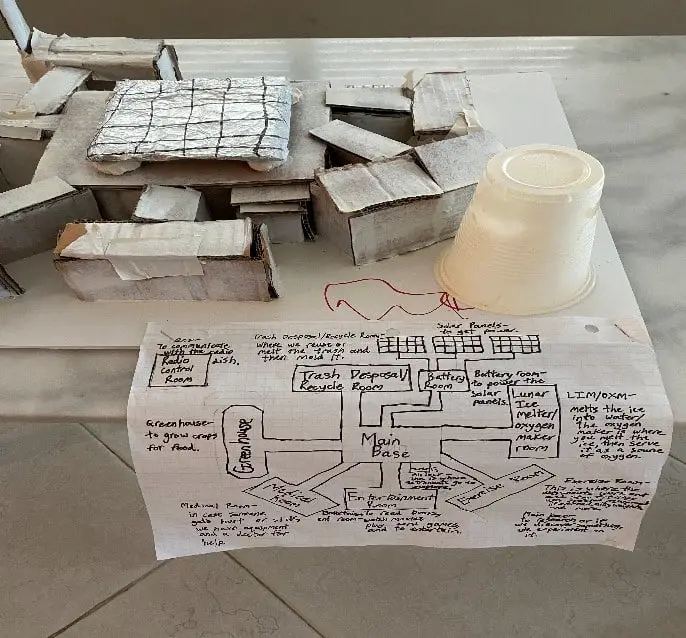
Image Credit (Above and Below): TelescopeGuide.org
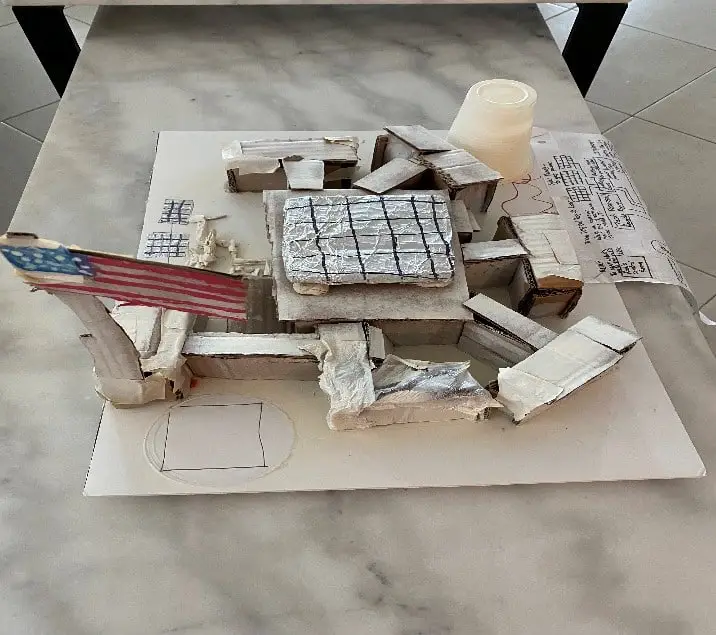
Gravity & Orbit Demonstrations
Why do objects orbit other objects in space, seemingly forever? We’ve designed a simple demonstration with a marble, a tennis ball and a kitchen bowl to help to help younger kids visualize how gravity affects the trajectory of an object as it flies through space.
Before demonstrating this, it helps to explain the delicate “tug of war” between the velocity (speed) of an object vs. the gravitational pull of the larger object that it’s orbiting.
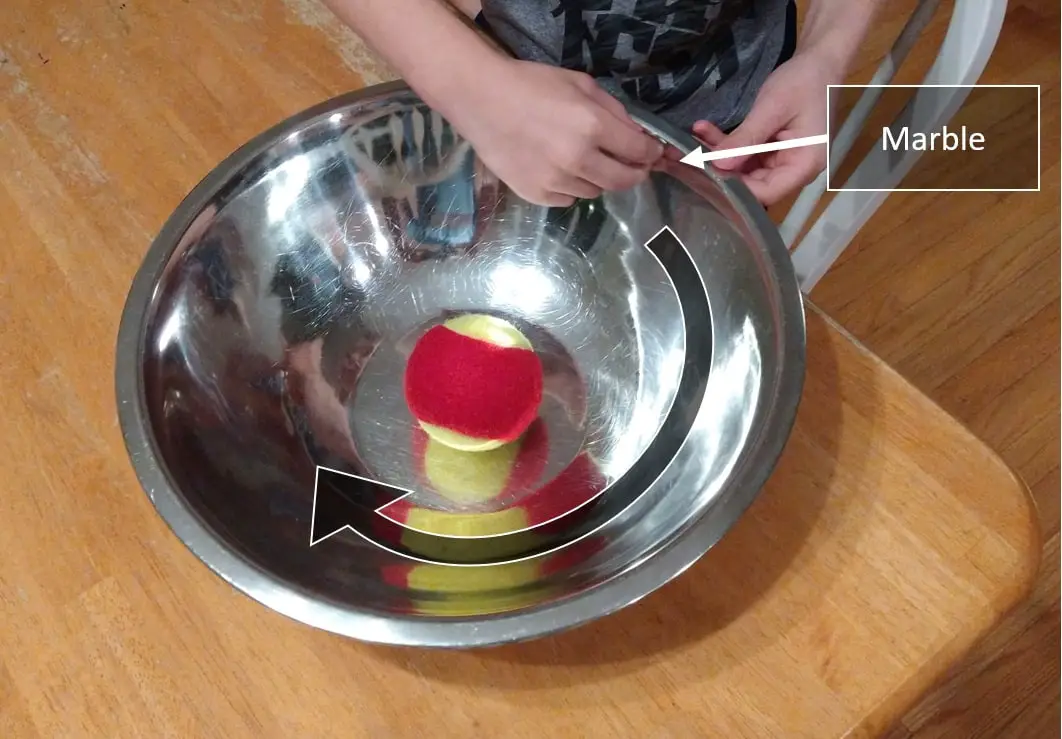
Image Credit: TelescopeGuide.org
To conduct the demonstration, try to throw the marble so that it “orbits” the tennis ball for as long as possible. (To make this even more fun, have a little competition and see who can get the marble to stay in orbit the longest.) While doing this simple experiment, you can explain some basic concepts about how gravity and velocity combine to keep objects in orbit:
- If the marble goes too slow, it falls towards the center. If it goes too fast, it flies out of the bowl. The speed has to be “just right” to keep it in orbit.
- Why doesn’t the marble keep going around forever? (Answer: Friction! In the bowl, friction occurs between the marble and the bowl itself, which causes the marble to slow down (i.e., lose velocity. The object would not slow down in space as there’s no friction.)
- Try making the orbit elliptical (oval-shaped.) Planets, moons, asteroids and comets don’t have simple, perfectly circular orbits; they’re almost all elliptical to some extent or another, with the object (the marble) being closest to their parent body (the tennis ball) at one point and furthest from its parent body at another. This is especially true of comets, which tend to have highly elliptical orbits. (We call the closest point to the Sun in a body’s orbit the perihelion, and the furthest point the Similarly, when a body is closest to the Earth, we call that point the perigee, and we call the point when it’s furthest the apogee.)
While this simple demonstration works best for younger kids, you might be surprised to see teenagers getting interested as well. In fact, teachers and parents can take this demonstration to the next level, and actually demonstrate the bend of objects on the fabric of space-time.
To do that, you can repeat this same concept but replace (1) the bowl with a bed sheet spread out and either fastened to supports around the edges (e.g., comparable to a trampoline) or held by the children at the corners, (2) the tennis ball with a heavier weight or object (e.g., a basketball) placed in the middle of the bed sheet, and (3) the single marble with multiple marbles.
The object in the middle of the bed sheet will warp the sheet, much like a planet warps space-time. This warping will draw other, smaller objects rolled on the sheet, like the marbles, toward and into the orbit of the heavier object, just as the warping of space-time results in gravity.
This “advanced” version of the gravity and orbit demonstration results in some really amazing orbital patterns and nuances. We learned this version of the experiment from Ben Finio, PhD, of Science Buddies. You can find more information, and see it in action, here:
Finio, Ben. “A Model of Gravity in Our Solar System.” Science Buddies, 20 Nov. 2020, https://www.sciencebuddies.org/science-fair-projects/project-ideas/Astro_p043/astronomy/model-gravity-solar-system. Accessed 16 Nov. 2021.
Moon Phases Demonstration
One thing that’s often a source of confusion is why the Moon always keeps the same side facing toward us, and how the phases of the Moon occur. You can demonstrate in a fun way by having a basketball to represent the Earth, a tennis ball to represent the Moon and a bright flashlight or lamp to represent the Sun.
Using a black marker, draw a line encircling the tennis ball so that it passes through what would be the Moon’s north and south poles. Then have a student draw their representation of the Moon on one side of the tennis ball. We’d see this side from the Earth, whereas we’d never see the unmarked side.
(Although we call this side the “dark side of the Moon,” in reality – as students will see – it gets as much sunlight as the rest of the lunar surface.)
We only see one side of the Moon from Earth because the Moon’s rotation period (its “day”) is the same as its orbital period about the Earth. This concept is a bit difficult to explain, which is why this activity provides a great, practical demonstration.
The activity works best at night or in a room that’s been darkened. Place the basketball (the Earth) in the center of the room and the flashlight (the Sun) near a wall. Lastly, place the tennis ball (the Moon) about midway between the Earth and the Sun – but make sure the marked side of the Moon faces the Earth. (Note that this is not to scale!)
Turn on the flashlight and turn out the lights or close the blinds so that the room is dark. The flashlight should half illuminate the basketball (Earth) and tennis ball (Moon). (The tennis ball might cast a shadow on the basketball but ignore this for now.)
The illuminated half of the basketball represents the daylight side of the Earth, whereas the darkened half represents the night side of the Earth. The divide between the lit and unlit sides of the Earth is twilight; as seen from above, the left side of the Earth represents the afternoon and evening, whereas the right side represents the hours after midnight and morning.
When the Moon moves between the Earth and the Sun, it’s a new Moon and can’t be seen from the Earth as it appears too close to the Sun in the daytime sky.
(Students might also notice that the unmarked side of the Moon – the “dark side” – is actually fully illuminated by sunlight at this time but, because it’s turned away from the Earth, we can’t see it.)
Now move the Moon a counter-clockwise through a quarter of its orbit so that it’s to the left of the Earth (as seen from above.) At the same time, rotate the Moon clockwise a quarter of a turn so that the line through its poles faces the Sun, perpendicular to the divide between the day and night side of the Earth.
This represents the Moon at first quarter (so-called because the Moon has moved a quarter of the way through its orbit), and it appears as a half Moon in our sky. From the Earth’s perspective, it’s visible in the afternoon and evening and is south at sunset.
Now move the Moon counter-clockwise another quarter again so that it’s on the opposite side of the Earth from the Sun. At the same time, rotate the Moon clockwise again by a quarter turn, so that the entire marked side faces the Earth.
This represents the full Moon, when we see the entire sunlit half of the Moon’s surface from the Earth. The Moon is visible throughout the evening through to the early hours of the morning. It rises at sunset, is south at midnight, and then sets at sunrise.
Now move the Moon again counter-clockwise another quarter and rotate it clockwise by a quarter. The Moon is now on the right side of the Earth (as seen from above) and, once again, the flashlight illuminates half the Moon’s surface. This time, it’s the opposite half of the Moon compared to the Moon at first quarter.
We call this phase of the Moon the last quarter (or sometimes third quarter) as it’s now moving into the last quarter of its orbit. It’s visible from the early hours of the morning and throughout the morning itself. It rises around midnight, is south at dawn and then sets around midday.
Lastly, move and rotate the Moon back to its starting position and we’re back to new Moon again.
Additional Activity Resources
While researching this leaflet, we came across some other interesting astronomy related resources, and hands-on activities to introduce kids to space:
- NASA at Home: https://www.nasa.gov/nasa-at-home-for-kids-and-families
- NASA’s Night Sky Network, Supernova Demonstration: https://nightsky.jpl.nasa.gov/download-view.cfm?Doc_ID=339
- Science Buddies Astronomy Projects: https://www.sciencebuddies.org/science-fair-projects/project-ideas/astronomy
- Homeschool space activities for kids: https://www.homeschool-activities.com/space-for-kids.html
Additional Kids-Related Resources at TelescopeGuide.org
- 5 Simple Space Activities for Kids
- Space Gift Ideas for Astronomy-Loving Kids
- Our Top Telescope Recommendations for Kids
- Review of KiwiCo’s Astronaut Starter Kit & Solar System Model
- Our Guide to the Best Star Projectors for Kids
The Take-Away: Kids of Every Age Can Learn Astronomy
Every science educator or parent who values a STEM-centric education should consider incorporating astronomy for kids into their curriculum.
Astronomy is a practical, multi-disciplinary science that helps inspire the imaginations and scientific curiosity of children. The mystery of the night sky still draws us in, and studying astronomy can offer an exciting adventure.
By gaining exposure to astronomy from an early age, young learners lay the foundation for lifelong enrichment and may just catch that same spark as Neil de Grasse Tyson or Ana Humphrey.
We’ve provided you with several key tips and project ideas to help you down this path. If you have any questions, feel free to reach out to us using our contact page (link at bottom of page), as well as more informative articles and recommendations on getting started with astronomy.
Click Here to Download or Share
(Also, if you liked this article, please share it using the social media buttons below!)
*** Special thanks to Richard Bartlett & Laboni Hasan ***
Feature Image Credit: pexels.com / Kindel Media

